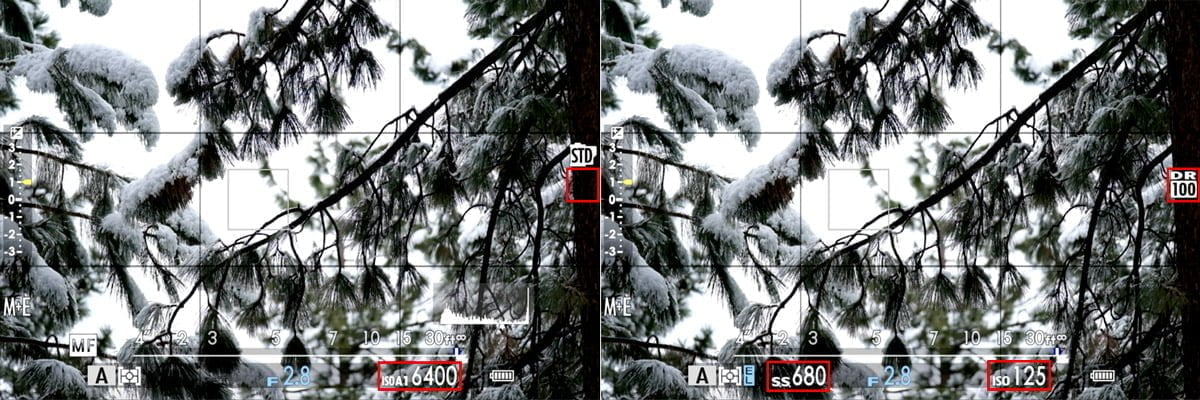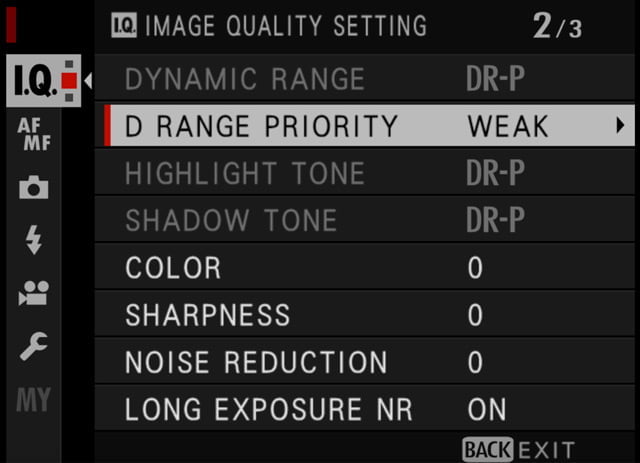Disclosure: This post may contain affiliate links. I earn a small commission of product sales to keep this website going.
I’ve fielded many questions over the years about how the Fujifilm Dynamic Range setting works with Auto ISO. The Dynamic Range and ISO settings are linked, so what happens if ISO is in Auto?
This article will explain how the two settings work with one another in various situations.
What is Dynamic Range?
The Fujifilm Dynamic Range setting will help you retain some highlight detail in high-contrast scenes. This allows you to increase your exposure slightly so that your shadows aren’t too dark, but your bright areas won’t be too bright.

That’s a totally simplified explanation, and you can read this article for a more in-depth explanation of Dynamic Range.
You need a specific minimum ISO to use the Dynamic Range settings, all based on the camera’s native base ISO. Reference the table below for the minimum required ISOs based on your camera’s base ISO.
| Base ISO | Min for DR200 & DR AUTO | Min for DR400 |
|---|---|---|
| 100 | 200 | 400 |
| 125 | 250 | 500 |
| 160 | 320 | 640 |
| 200 | 400 | 800 |
Please note this refers to the native ISO, not the extended ISO.
What is Auto ISO?
Auto ISO allows you to specify an ISO range in which the camera may operate. This simplifies your task load when exposing in nearly all exposure modes. You just tell the camera, “pick whatever ISO you need as long as it’s between 160 and 3200,” for example.
That is, again, a simplified explanation of Auto ISO, and you can read this article for a more in-depth explanation.

Your camera display using Auto ISO
This is an important consideration when using Dynamic Range with Auto ISO.
Please note that when you’re in an Auto ISO program, the camera will always display the maximum ISO in the display. For example, if you’re in your AUTO1 program with a maximum ISO of 6400, you’ll always see “A1 6400” in the display.
Once you press the shutter halfway or AEL, you’ll see the camera’s chosen ISO value there. If you’re in DR AUTO, the camera will also show you which DR setting it’s chosen, 100 or 200, along with any other auto exposure variables.

Using Dynamic Range with Auto ISO
Now that we’ve briefly introduced Dynamic Range and Auto ISO, how do they work together? Will the camera prioritize the Dynamic Range setting or the Auto ISO setting? For example, if you set a minimum Auto ISO of 125, will the camera raise that to 250 if you have DR200 set? What about DR AUTO? Or will it stay at ISO 125 and leave Dynamic Range off?
The short answer is that, as long as your Auto ISO program has a high enough maximum ISO, your camera will prioritize your Dynamic Range setting over minimum ISO; it will always honor maximum ISO.
That is to say, if your Auto ISO program has a default (minimum) ISO of 125 and you have DR200 set, your “new” minimum ISO will be set to 250. If you set DR100 (off), your minimum ISO will return to 125.
Let’s look at some other scenarios assuming a camera native ISO of 125:
- Auto ISO 125 to 6400, DR200 set. The camera will maintain DR200 with a minimum ISO of 250, up to the maximum if needed.
- Auto ISO 125 to 6400, DR400 set. The camera will maintain DR400 with a minimum ISO of 500, up to the maximum if needed.
- Auto ISO 125 to 6400, DR AUTO set. The camera will choose between DR100 or DR200 based on the contrast. If it chooses 200, it will raise the minimum ISO to at least 250, up to the maximum if needed.
- Auto ISO 125 to 400. DR400 will be unavailable in the menus. Only DR100, DR200, and DR AUTO are available and will work as described above.




What about Dynamic Range Priority?
Dynamic Range Priority works in the same manner as Dynamic Range when it comes to requiring a minimum ISO; Dynamic Range is part of the Dynamic Range Priority setting. DR-P Weak correlates to DR200, and DR-P Strong correlates to DR400. DR-P AUTO, unlike DR AUTO, will choose between all DR-P options and thus requires the DR400 minimum ISO to choose DR-P Strong.

So that’s the quick and easy explanation of how Dynamic Range works with Auto ISO in Fujifilm cameras! Confused about your other camera settings? Check out our Fujifilm Camera Tutorial courses and use the code “blog20” for 20% off.
Please leave any questions or comments below.
